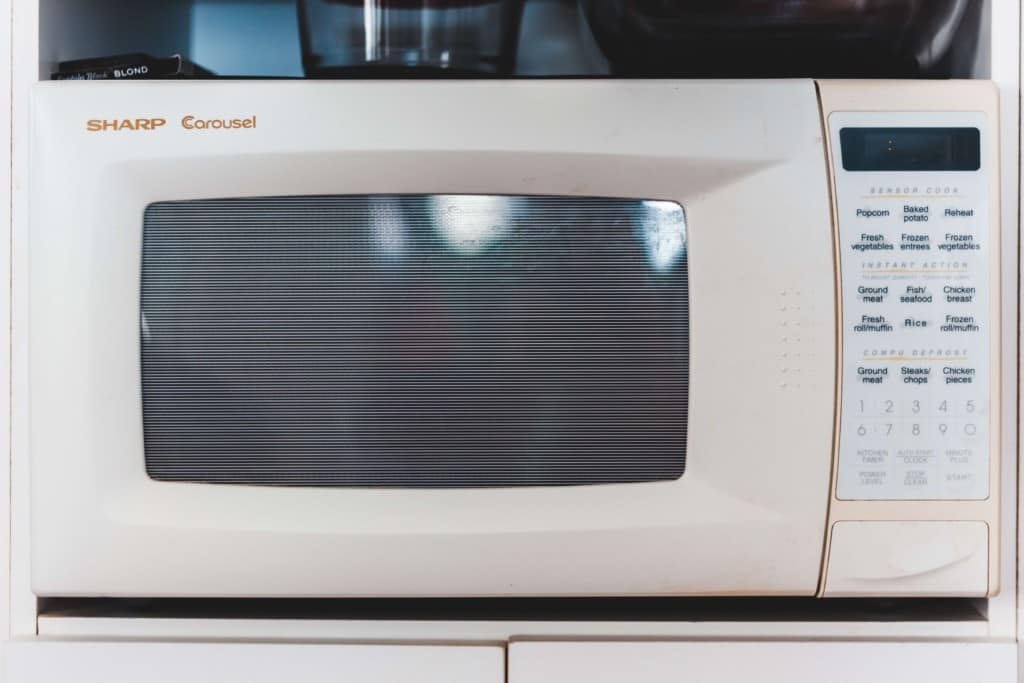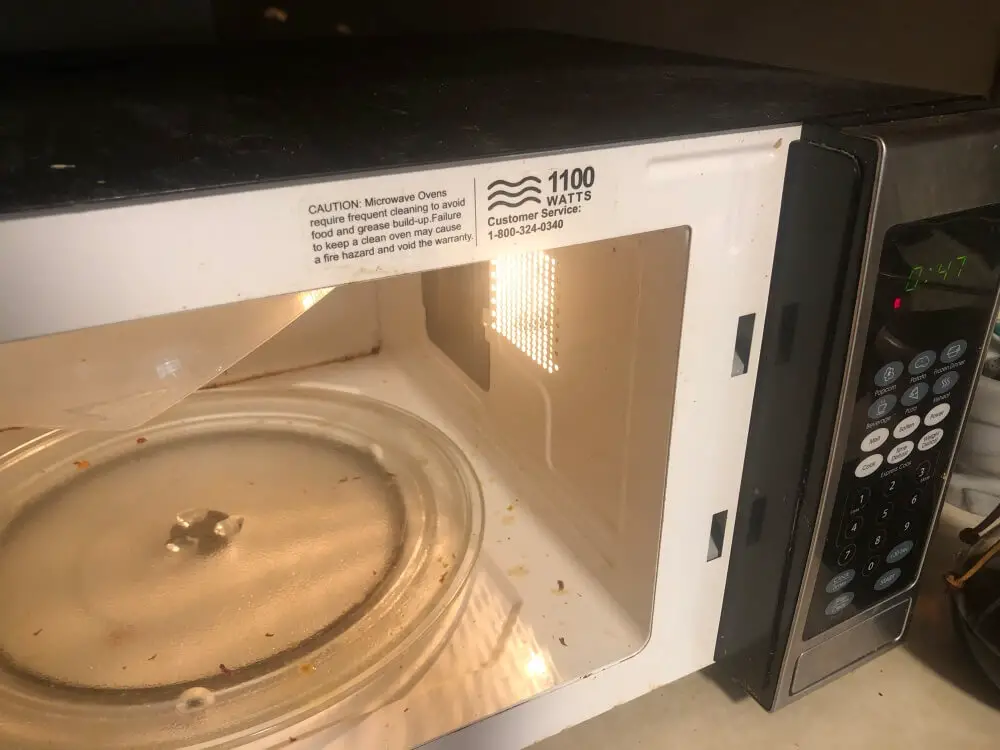There are many microwaves out there with different wattages, but there is a standard range that most microwaves stay within.
Standard microwave wattage is usually anywhere from 600 to 1,200 watts, but the average wattage is around 1,000. This standard wattage is enough power to heat things up quickly without the machine getting too powerful or too expensive.
When picking a microwave, it is important to think about how much wattage will work best for your situation. Read the details below to help you decide what wattage you’ll want for your microwave. Once you know the wattage you’re going for, it’ll make microwave shopping WAY easier.
Disclaimer: This post contains affiliate links. This means I may earn a commission should you choose to make a purchase using my link
Table of Contents
Standard Microwave Wattage

Most countertop microwaves come in wattages between 600-1200 watts. But the average microwave wattage most people have in their homes is 1000 watts.
The reason for this is that these machines tend to cook the most efficiently and evenly.
Efficiency is important because who wants to wait forever for a slow microwave? If microwaves were all slow super slow, then we’d probably just use an oven.
Even cooking is important because you’ll obviously want to avoid any frozen or cold spots when biting into your food. No one wants to find a block of ice when trying to eat microwaved food. This can be especially bad if you’re trying to cook raw foods.
Now that you know the average, the real question becomes which wattage microwave should you have.
What Wattage Microwave Should I Have?
It really depends on your needs as a microwave owner, no one wants to wait for something to cook for 6 minutes when it could be done in half the time with a higher-wattage microwave.
Here is a table that illustrates the differences in cooking time between several different microwave wattages:
| Wattage | Time it Takes to Heat Up a Cup of Water (Minutes) |
| 600 Watts | 4 |
| 700 Watts | 3 |
| 800 Watts | 2 1/2 |
| 1,000 Watts | 2 |
| 1,200 Watts | 1 1/2 |
With that said, most people opt for a microwave with around 1,000 watts. With that much power, you won’t have to wait too long to heat things up. In fact, you can heat up a cup of water in just two minutes!
Of course, you can get a higher-wattage microwave, but for most people, a microwave above 1,000 watts is probably not necessary for the extra price that they go for.
You could also consider a microwave with 800 to 900 watts, but below that isn’t good considering how long it takes to cook food or thaw things out.
No one wants to be eating undercooked microwave food which might be the case with a lower-wattage microwave. It’s also not worth getting a lower-wattage microwave based on price.
There are many microwaves under $130 that have 1,000 watts like this one on Amazon, especially if you don’t need any bells and whistles like having a metal rack in your microwave.
Why Does Wattage Matter?
The real question here is do the watts matter to YOU. The microwave’s wattage clearly has a mechanical/functional difference, but in your day-to-day use of a microwave will you care about the difference?
It will take much longer for a 600-watt microwave to heat up food than it would for a 1,200-watt microwave. So, if time is precious to you, you will want to lean towards a higher wattage microwave.
In most cases, people would say that wattage definitely matters in a microwave. There will be some who don’t mind waiting longer for their food to heat up. However, it is important to note that a smaller-wattage microwave might also cause you to eat undercooked microwave food.
Let’s use the example of Hot Pockets as an example to further illustrate the differences in microwave wattages.
With a lower-wattage microwave, you may find that the inside of your hot pocket is still frozen while the outside burns your mouth. In other words, lower wattages like 600-700 watts, can cause cold spots and cook unevenly or incompletely.
In addition, most frozen foods (like Hot Pockets) have directions for cooking them in the microwave, but it doesn’t provide multiple cook times for multiple different wattages. This is important to keep in mind and a point that a lot of people probably miss.
In the case of Hot Pockets, in the directions on the box, they provide the recommended cook time for a 1,100-watt microwave and then another cook time for a “Lower Wattage/Compact Microwave”.
So, if you have a 900-watt microwave, then you’ll have a bit of guesswork to do in order to make sure your Hot Pocket cooks completely (but doesn’t get overcooked).
This is because the directions are rated for microwave wattages that don’t perfectly align with the wattage of your microwave.
If you’re curious exactly how this looks as an example of how cook times vary between different microwaves, you can click HERE, to see the instructions for Hot Pockets where you will see both cook times.
While many can learn to adjust cooking times for their food if they have a smaller-than-recommended microwave, you can save yourself some time and guesswork by simply getting a microwave that is between 1,000 and 1,200 watts.
How to Find the Wattage of Your Microwave

The wattage of your microwave should be printed in two easy to find locations.
First, the details of your microwave might be printed on the microwave door either on the inside or around the edges when the door is open.
If there is no information on the door of the microwave, check the back of the microwave.
The back of the microwave should have a plate that has all the information you need such as wattage, serial number, etc…
If all of that fails and you happen to still have the owners manual, the wattage should also be listed there.
The wattage may be more difficult to find for old microwaves or commercial microwaves. In these cases you may have to look up your wattage with the manufacturer using the serial number of the microwave.
How Much Does it Cost to Run a Microwave?
Calculating the energy consumption to run your microwave will depend on what type of microwave you have. Having a lower wattage microwave will cost less than running higher-wattage microwaves. But, you have to run the lower water microwave for longer, so which one is better for your electric bill?
Let’s say that your microwave uses 1000 watts of electricity and you use it for about 15 minutes a day. That means you will use about 7.5 kWh (kilowatt hours) of energy per month.
The national average for the United States for cost of energy per kWh is $0.173 which means you will pay about $1.3 per month to use your microwave.
If you have a microwave that is 800 watts but you have to use it for 20 minutes a day instead, then you will use about 7.2kWh of energy per month which translates to $1.25 per month in energy costs.
So, if you’re all for energy efficiency, using low-wattage microwaves is slightly more energy efficient than using the average microwave wattage of 1000 watts.
But, if you use your microwave a lot and need it to work quickly, you may still want to use the more powerful microwave.
As far as kitchen appliances go, microwave use is a pretty low strain on your electricity bill. Using microwaves and slow cookers are great ways to cut your energy bill down.
Related Questions
Is 900 or 800 Watts Enough for a Microwave?
Though a 1,000-watt microwave is commonly recommended, 800 or 900 watts isn’t necessarily a bad choice. In fact, a 100-watt difference is not going to change much in terms of the length of time needed to heat things up, see the table with times earlier in this post.
Should I Buy a Microwave Below 800 Watts?
It is important to get a microwave with a wattage of at least 800 to get the best experience. Most people will recommend a microwave of at least 1,000 watts. These microwaves tend to cook food evenly and quickly.
Can You Put a Microwave on a Refrigerator?
You can put a microwave on top a refrigerator and it’s a great way to save counter space in a small kitchen. You’ll want to make sure your microwave is able to fit fully on top of the microwave so you don’t risk it falling off. For more information about this, check out our other post: Can You Put a Microwave On A Fridge, In a Cabinet, and More?
